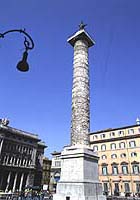Column of Marcus Aurelius
(Colonna di Marco Aurelio) (176-193 AD). In olden times Rome was full of columns erected to glorify wars won, grandiose personages and the "Triumph" of something or someone.
They were mostly for self-glorification and this is no exception.
Like Trajan's, the column is exactly 100 Roman feet high and made of 27 superimposed marble drums. But this column tapers less than Trajan's Column and therefore seems more massive. The sculptured spiral band turns on itself 21 times.
The whole thing is 126 feet/42m high, including the statue on top; ground level was 12 feet/4m lower in those days (remember all that rubbish everybody was throwing out with impunity in the Dark Millennium).
Within the column are 203 stairs corkscrewing up to the statue.
Special permission is needed to visit inside.
| Column of Marcus Aurelius History
193 AD. The column was finished. In Imperial times there were two temples, the Column of Antonius Pius and a crematorium nearby. Plus the largest clock ever built in the world: the Sun Dial which was as large as Piazza del Popolo (now buried under nearby shops and palaces). 1589. The statue of the Emperor was taken down and Pope Sixtus V Peretti replaced it with St. Paul. |
Piazza Colonna (Map H 4)
 176 AD. Inspired by Trajan's nearby column, this one was erected, commemorating Marcus Aurelius' wars and victories - which are recorded on a sculpture band, which spirals up the column's surface, like an extended comic strip. This is the same Emperor as the one in the fabulous statue of man and horse in the
176 AD. Inspired by Trajan's nearby column, this one was erected, commemorating Marcus Aurelius' wars and victories - which are recorded on a sculpture band, which spirals up the column's surface, like an extended comic strip. This is the same Emperor as the one in the fabulous statue of man and horse in the